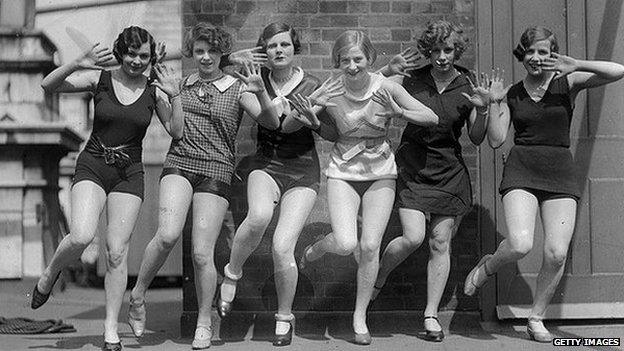What do twerking and the Charleston have in common?
- Published

When twerking first made the headlines it divided public opinion, but it's not the only dance that caused controversy in its era, says Lucy Wallis.
As Miley Cyrus thrusted and gyrated at the MTV Video Music Awards in 2013, her uninhibited dance moves got everybody talking. Twerking entered the public consciousness and even the Oxford Dictionary of English.
With the weight of the body positioned well forward, twerking involves the shaking and isolation of the hips and bottom. It is not the first time in history that such wild movements have become a dance sensation.
"Twerking [is] nothing new, it's from the Charleston," says dancer and choreographer Jreena Green, who likens the 1920s moves of the flapper to the erratic hip shaking of contemporary pop artists such as Beyonce.
The dance first originated in the city of Charleston in South Carolina, but it was the influence of entertainers, such as Josephine Baker - the Beyonce of her day - that brought it to Britain. "Baker danced it at the Folies Bergère in Paris in 1926, but it's actually popularised by a tune called the Charleston which was in the [Broadway] show Runnin' Wild," says Darren Royston, historical dance teacher at Rada.
Women took on male-dominated roles in the workplace during World War One and after the war the Charleston captured this new-found spirit of female liberation, says historian Lucy Worsley. "When the Charleston arrived from America in 1925 it took the dance floor by storm. It allowed women to break free from a man's embrace and dance on her own," she says.
But many feared the image of the flapper with her bobbed hair and shorter skirt length was a sign womanhood had been lost to the jazz age. "She smoked, she drank, she danced the Charleston with reckless abandon," says Worsley.
A disgruntled soldier who had been dreaming of the modest girls back home during WW1 complained via a letter in the Daily Express in the 1920s that "instead of the girls of our fondest imagination, we find them madly given over to dancing".

The Charleston - A dangerous dance
The Charleston had a syncopated rhythm and involved inverting the knees and using kicks and wild arm movements.
Criticism was levied at the dance for its reckless style, but also its damaging effect on the body.
With the continuous twisting and turning of the knees there were risks involved, says Royston. "People could get bad 'Charleston knee.' Obviously you're working your way up to a sweat as well, which is not necessarily seen to be as ladylike as you'd want."

"I don't think the Charleston was at all sexually overt," Royston says. "I don't think it's at all, in our eyes, raunchy, whereas twerking is clearly a very sexed up dance."
Dancing Cheek to Cheek: An Intimate History of Dance starts on Monday 17 November at 21:00 GMT on BBC Four. Or catch up later on BBC iPlayer